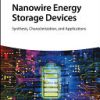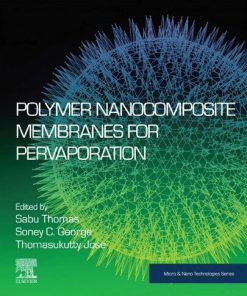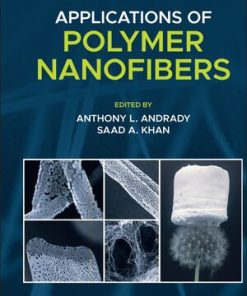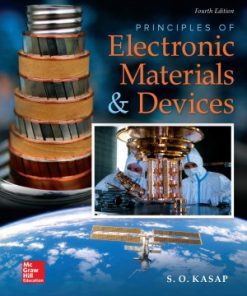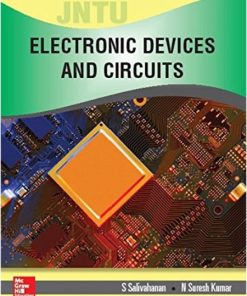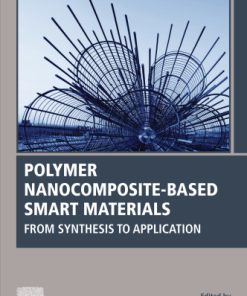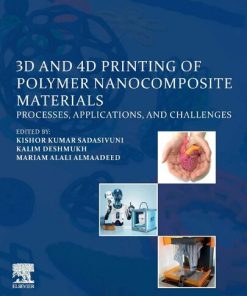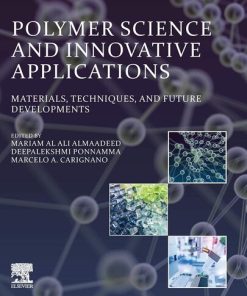(Ebook PDF) Polymer Nanocomposite Materials Applications in Integrated Electronic Devices 1st edition by Ye Zhou, Guanglong Ding 3527347445 978-3527347445 full chapters
$50.00 Original price was: $50.00.$25.00Current price is: $25.00.
Polymer Nanocomposite Materials: Applications in Integrated Electronic Devices 1st edition by Ye Zhou, Guanglong Ding – Ebook PDF Instant Download/DeliveryISBN: 3527347445, 978-3527347445
Full download Polymer Nanocomposite Materials: Applications in Integrated Electronic Devices 1st edition after payment

Product details:
ISBN-10 : 3527347445
ISBN-13 : 978-3527347445
Author: Ye Zhou, Guanglong Ding
Polymer Nanocomposite Materials
Discover an authoritative overview of zero-, one-, and two-dimensional polymer nanomaterials
Polymer Nanocomposite Materials: Applications in Integrated Electronic Devices delivers an original and insightful treatment of polymer nanocomposite applications in energy, information, and biotechnology. The book systematically reviews the preparation and characterization of polymer nanocomposites from zero-, one-, and two-dimensional nanomaterials.
The two distinguished editors have selected resources that thoroughly explore the applications of polymer nanocomposites in energy, information, and biotechnology devices like sensors, solar cells, data storage devices, and artificial synapses. Academic researchers and professional developers alike will enjoy one of the first books on the subject of this environmentally friendly and versatile new technology.
Polymer Nanocomposite Materials: Applications in Integrated Electronic Devices 1st Table of contents:
1 Introduction of Polymer Nanocomposites 1
Teng Li, Guanglong Ding, Su-Ting Han, and Ye Zhou
1.1 Introduction 1
1.2 The Advantage of Nanocomposites 3
1.3 Classification of Nanoscale Fillers 5
1.3.1 One-Dimensional Nanofillers 5
1.3.2 Two-Dimensional Nanofillers 6
1.3.3 Three-Dimensional Nanofillers 6
1.4 The Properties of Polymer Nanocomposites 6
1.5 Synthesis of Polymer Nanocomposites 7
1.5.1 Ultrasonication-assisted Solution Mixing 8
1.5.2 Shear Mixing 9
1.5.3 Three Roll Milling 9
1.5.4 Ball Milling 10
1.5.5 Double-screw Extrusion 10
1.5.6 In Situ Synthesis 10
1.6 Conclusions and Future Outlook 11
References 11
2 Fabrication of Conductive Polymer Composites and Their Applications in Sensors 21
Jiefeng Gao
2.1 Introduction 21
2.2 Fabrication Methods for CPCs 22
2.2.1 Melt Blending 23
2.2.2 Solution Blending 25
2.2.3 In Situ Polymerization 27
2.3 Morphologies 27
2.3.1 Random Dispersion of Nanofiller in the Polymer Matrix 27
2.3.2 Selective Distribution of Nanofillers on the Interface 29
2.3.2.1 Segregated Structure 29
2.3.2.2 Surface Coating 31
2.4 Application in Sensors 32
2.4.1 Strain Sensor 33
2.4.2 Piezoresistive Sensor 33
2.4.3 Gas Sensor 35
2.4.4 Temperature Sensor 38
2.5 Conclusion 40
References 41
3 Biodegradable Polymer Nanocomposites for Electronics 53
Wei Wu
3.1 Introduction 53
3.2 Biodegradable Polymer Nanocomposites in Electronics 55
3.2.1 Polylactide 55
3.2.2 PCL 58
3.2.3 PVA 59
3.2.4 PVP 61
3.2.5 Cellulose 62
3.2.6 Chitosan 64
3.2.7 Silk 65
3.3 Challenges and Prospects 66
List of Abbreviations 67
References 67
4 Polymer Nanocomposites for Photodetectors 77
Raj Wali Khan, Zheng Wen, and Zhenhua Sun
4.1 Introduction 77
4.2 Photodetector Brief 79
4.2.1 Photodiode 80
4.2.2 Photoconductor 80
4.3 Photodetectors Based on Novel Semiconductors 82
4.4 Photodetectors Based on Polymer Nanocomposites 87
4.4.1 Polymer–Polymer Nanocomposite 88
4.4.2 Polymer–Small Molecular Organic Nanocomposite 98
4.4.2.1 MEH-PPV–Small Molecular Organic Nanocomposite 98
4.4.2.2 P3HT-Small Molecular Organic Nanocomposite 99
4.4.3 Polymer–Polymer–Small Molecular Organic Nanocomposite 107
4.4.4 Polymer–Small Molecular Organic–Small Molecular Organic Nanocomposite 110
4.4.5 Polymer–Inorganic Nanocrystals Nanocomposite 112
4.4.5.1 MEH-PPV–Inorganic Nanocrystals Nanocomposite 112
4.4.5.2 P3HT–Inorganic Nanocrystals Nanocomposite 115
4.4.6 Polymer–Small Molecular Organic–Inorganic Nanocrystals Nanocomposite 120
4.5 Outlook 123
List of Abbreviations 123
References 124
5 Polymer Nanocomposites for Pressure Sensors 131
Qi-Jun Sun and Xin-Hua Zhao
5.1 Introduction 131
5.2 Parameters for Pressure Sensors 132
5.2.1 Pressure Sensitivity 132
5.2.2 Linear Sensing Range 134
5.2.3 LOD and Response Speed 134
5.2.4 Reliability 134
5.3 Working Principles and Examples of Polymer Nanocomposite Based Pressure Sensors 135
5.3.1 Capacitive Pressure Sensors 135
5.3.2 Piezoresistive Pressure Sensors 137
5.3.3 Piezoelectric and Triboelectric Tactile Sensors Based on Polymer Nanocomposites 143
5.4 Applications of the Polymer Nanocomposite Based Pressure Sensors 148
5.4.1 Human Wrist Pulse Detection 148
5.4.2 Subtle Human Motion Detection 149
5.4.3 Texture Roughness Detection 151
5.4.4 E-skin Application 152
5.5 Performance of Pressure Sensors with the Polymer Nanocomposites Reported Over the Past Decade 153
5.6 Conclusion 154
References 154
6 The Application of Polymer Nanocomposites in Energy Storage Devices 157
Ningyuan Nie, Mengmeng Hu, Jie Liu, Jiangqi Wang, Panpan Wang, Hua Wang, Zhenyuan Ji, Zhe Chen, and Yan Huang
6.1 Introduction 157
6.2 Electrodes 158
6.2.1 For Battery 158
6.2.1.1 Polymer–Graphene/Carbon Nanotube 158
6.2.1.2 Polymer Inorganic 161
6.2.1.3 Polymer–Organic Salt Graphene 163
6.2.2 For Supercapacitor 164
6.2.2.1 Polymer–Metal Oxide 165
6.2.2.2 Polymer–Graphene/Carbon Nanotube 165
6.2.2.3 Polymer–Metal Oxide–Graphene/Carbon Nanotubes 169
6.3 Electrolytes 171
6.3.1 For Battery 171
6.3.2 For Supercapacitor 172
6.4 Separator 174
6.4.1 For Battery 174
6.4.2 For Supercapacitors 175
6.5 Conclusion 176
References 177
7 Functional Polymer Nanocomposite for Triboelectric Nanogenerators 189
Xingyi Dai, Jiancheng Han, Qiuqun Zheng, Cheng-Han Zhao, and Long-Biao Huang
7.1 Introduction 189
7.2 Triboelectric Nanogenerators 190
7.3 Functional Polymer Nanocomposite 194
7.4 Self-healing Triboelectric Nanogenerators 197
7.5 Shape Memory Triboelectric Nanogenerators 201
7.6 Biodegradable Triboelectric Nanogenerators 204
7.7 Conclusion 208
References 208
8 Polymer Nanocomposites for Resistive Switching Memory 211
Qazi Muhammad Saqib, Muhammad Umair Khan, and Jinho Bae
8.1 Introduction 211
8.2 Resistive Switching Memory for Polymer Nanocomposite 213
8.2.1 Resistive Switching 213
8.2.2 Resistive Switching Memory Operating Mechanism 214
8.2.2.1 Formation and Rupture of Conductive Filaments 214
8.2.2.2 Cations and Anions Migration 216
8.2.2.3 Electrons Trapping and De-tapping 216
8.2.2.4 Other Conduction Mechanisms 216
8.2.3 Fabrication Techniques 217
8.2.4 Polymer Nanocomposite Materials 218
8.3 Polymer Nanocomposite Based RSM Devices 218
8.3.1 Oxide Based Polymer Nanocomposite RSM 218
8.3.2 Metal Based Nanoparticles for Polymer Nanocomposite RSM 222
8.3.3 Graphene Based Polymer Nanocomposite RSM 224
8.3.4 Quantum Dot Based Polymer Nanocomposite RSM 227
8.3.5 Polymer Based Nanocomposites for RSM 229
8.3.6 2D Material Based Polymer Nanocomposites RSM 231
8.3.7 Other Materials Used for Polymer Nanocomposite Based RSM 232
8.4 Concluding Remarks 233
Acknowledgments 234
References 234
8.A Performance Comparison According to Device Material and Structure 243
9 Polymer Nanocomposites for Temperature Sensing and Self-regulating Heating Devices 247
Yi Liu, Han Zhang, and Emiliano Bilotti
9.1 Introduction 247
9.2 Conducting Mechanism and Percolation Theory 248
9.3 PTC Theory 249
9.4 Main Factors Influencing the PTC Effect 250
9.4.1 Effect of Filler Size and Shape 250
9.4.2 Effect of Filler Dispersion and Distribution 253
9.4.3 Effect of Mixed Filler 254
9.4.4 Effect of Polymer Thermal Expansion and Crystallinity 255
9.4.5 Effect of Polymer Transition Temperature 257
9.4.6 Effect of Polymer Blend 257
9.5 Temperature Sensors 259
9.6 Self-regulating Heating Devices 259
9.7 Conclusions 262
References 263
10 Polymer Nanocomposites for EMI Shielding Application 267
Ajitha A. Ramachandran and Sabu Thomas
10.1 Introduction 267
10.2 Mechanism of EMI Shielding of Polymer Composites 268
10.2.1 Materials for EMI Shielding 269
10.3 Polymer Nanocomposites for EMI Shielding Application 270
10.3.1 Nanofiller Incorporated Conducting Polymer Composites 270
10.3.2 Polymer Blend Nanocomposites for Electromagnetic Interference (EMI) Shielding 271
10.3.3 Conducting Polymers for EMI Shielding Application 272
10.4 Characterization Techniques Used for the Electrical Studies of Polymer Composites 274
10.4.1 Conductivity Studies of Polymer Composites 274
10.4.2 Electromagnetic Interference (EMI) Shielding Studies 276
10.5 Conclusion 278
People also search for Polymer Nanocomposite Materials: Applications in Integrated Electronic Devices 1st:
polymer nanocomposite based smart materials
what material is polymer
polymer materials examples
what are polymer composite materials
what are natural polymers made of
Tags:
Polymer Nanocomposite,Materials,Applications,Integrated Electronic,Devices,Ye Zhou, Guanglong Ding
You may also like…
Engineering
Engineering
Engineering - Electrical & Electronic Engineering
Physics - Quantum Physics
Engineering - Industrial Engineering & Materials Science
Engineering



